This buttercream icing recipe for cake decorating (also commonly known as American buttercream frosting), is the most basic type of icing or frosting for cakes. It only requires 2 basic and simple ingredients and you can whip a batch of fluffy buttercream frosting in under 20 minutes with a consistency that is perfect for frosting a cake as well as piping.
This buttercream icing is also so versatile that you can flavor it to any flavor you like and color it to any color you like too!
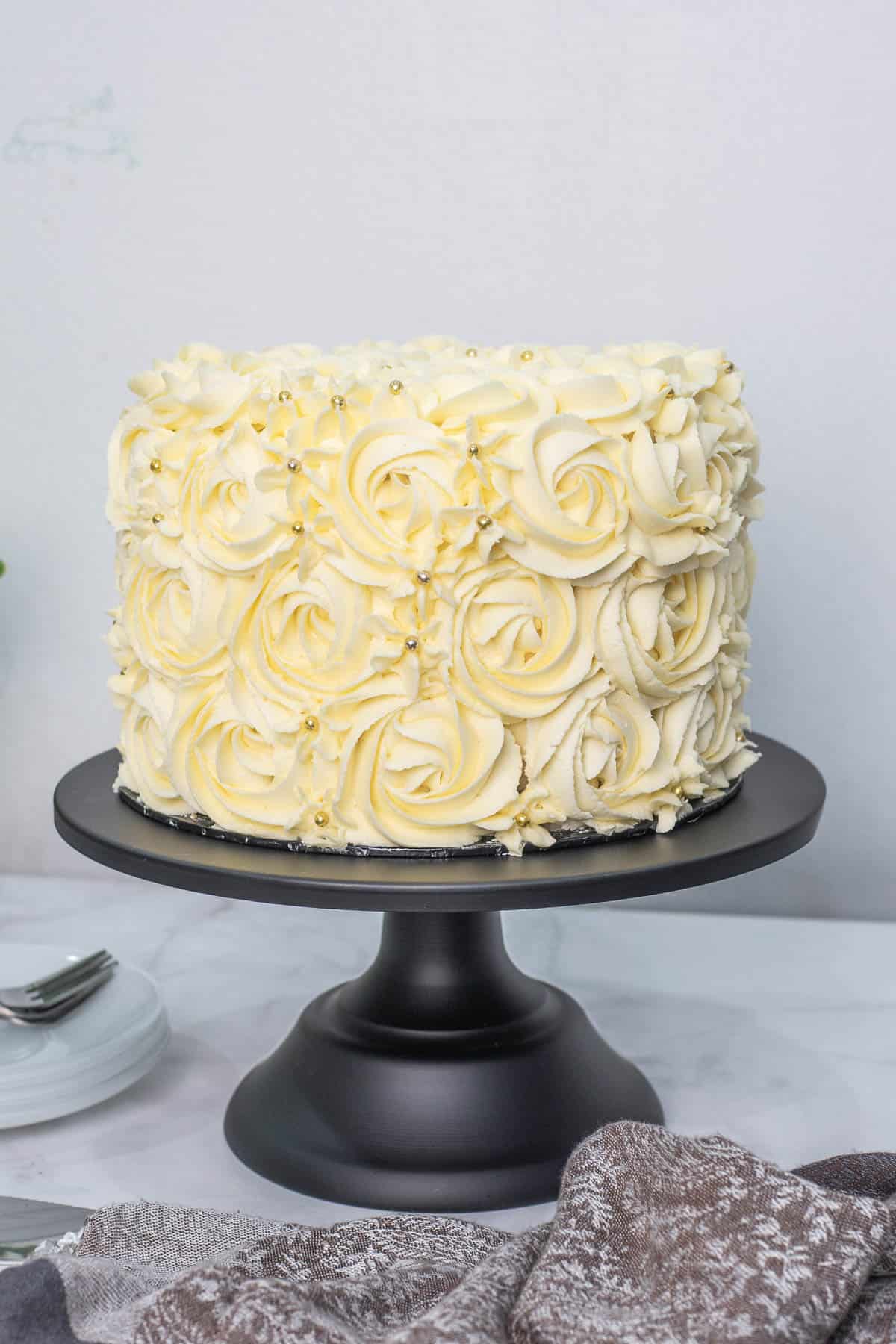
Jump to:
❤️Why you will love this recipe
- This is an easy buttercream frosting recipe and you need less than 20 minutes to whip up a batch of perfect buttercream frosting.
- The recipe requires very basic ingredients, with butter and powdered sugar being the main ingredients.
- You can use one recipe to make a whole lot of different flavors for your buttercream.
- With the use of real butter, this recipe makes the best vanilla buttercream frosting, and is way better than store-bought frosting.
- The frosting has a perfect consistency for cake filling, frosting and piping.
Like this easy homemade frosting recipe? Here are my other posts you might want to check out
- Glaze Icing
- Royal Icing Recipe (2 Easy Recipes with Meringue Powder and Egg Whites)
- Butter Icing Recipe
- Homemade Fondant Recipe
- Chocolate Ganache Recipe
- Salted Caramel Recipe (How to Make)
- Cream Cheese Frosting
- Simple Buttercream Flowers
- Buttercream Flowers Cake Decorating Tutorial
- How to Make Buttercream Daisy Cupcakes
- Buttercream Basket Weave Cake Decorating
- How to Make a Rosette Cake with Buttercream
📋Ingredients
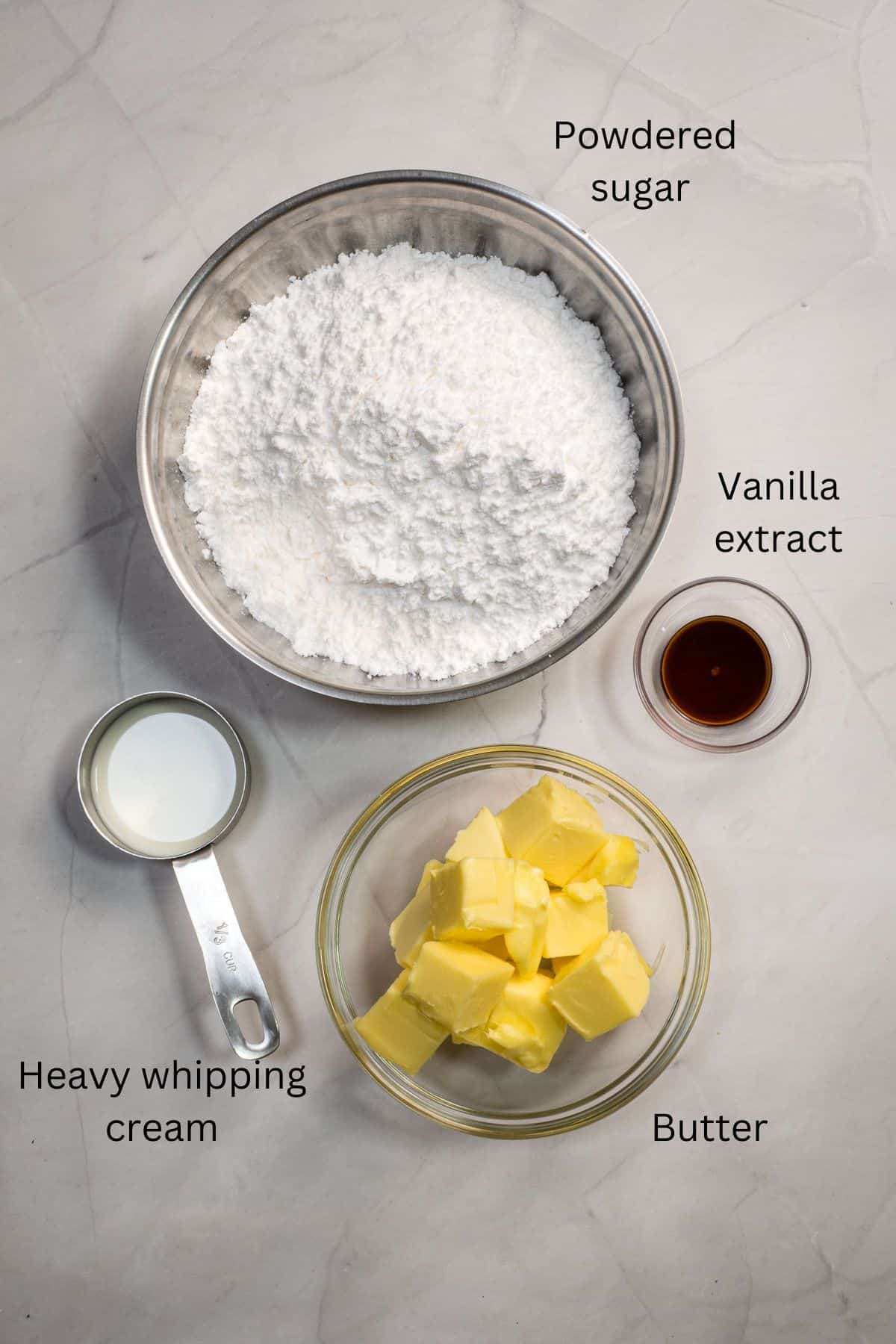
1. Butter
- I use salted butter to make the buttercream and it definitely makes a better tasting buttercream. For best results, use real butter. If you are using unsalted butter, add about one eighth of a teaspoon of fine salt with the sugar. Do not be overly generous with the amount of salt you add to this buttercream icing recipe. You only need a small amount.
- For best results, the butter should be firm but soft enough to press with a finger. Sometimes, room temperature butter may be too soft, especially if you are living in a warm temperature. If the butter is too soft to the point it is no longer able to hold its shape, return the butter to the fridge until it firms up before making the buttercream icing.
- If the butter is too cold and hard, it will take a long time to cream it to a creamy consistency. For best buttercream frosting, the butter should be cold and firm, but soft enough to cut into cubes without much effort.
2. Powdered sugar (icing sugar or confectioner's sugar)
- It is a must to sift the powdered sugar before using as powdered sugar tend to be lumps and these lumps do not always break, even when beaten with a mixer.
3. Pure vanilla extract
- Use good quality vanilla extract for vanilla flavored buttercream. See the "Substitution and variations" for other flavor options.
4. Heavy whipping cream (optional)
- This is optional and only required if the buttercream is too stiff. You will only need to use a small quantity in the buttercream, until you reach your desired consistency.
5. Food coloring (optional)
- Both gel based food coloring and liquid based colors will work for buttercream. However, gel food colors are best because they are concentrated and you need not use much, especially when you are trying to make deep and dark colors like red. Too much additional liquid can alter the consistency of the buttercream.
*Refer to the recipe card below for full list of ingredients and exact quantities. For best results, use a digital kitchen scale where applicable*
🧾Substitution and Variations
- Butter can be replaced with shortening. You can replace it entirely or proportionately. The buttercream will definitely taste better with all butter in it (without any shortening), but adding shortening stabilizes the buttercream and it will be better able to withstand warmer temperatures. Shortening also helps in making your buttercream naturally white. For heat stable buttercream, replace half of the butter with shortening. For an all white buttercream, replace all the butter with shortening.
- Heavy cream is optional and is not required if you buttercream is not overly stiff. If your buttercream is stiff, and you do not have any cream, you can use milk instead.
- Flavor variations:
- Vanilla bean buttercream - substitute the extract with scrapings of one vanilla bean.
- Chocolate buttercream - sift in 4 to 5 teaspoons of cocoa powder into the icing after mixing in the sugar. If the icing is too stiff, add some milk or heavy cream as indicated in the recipe card.
- Lime, lemon or orange buttercream frosting - Replace vanilla with 1 – 2 teaspoons of finely grated rind (zest).
- Strawberry and raspberry buttercream - Grind freeze dried fruits into fine powder and add to the buttercream after adding the sugar. Start with about 1 - 2 teaspoons of the powder and increase the amount to suit your liking.
- Buttercream frosting in banana, coconut, almond and mint flavors - replace the vanilla extract with these extracts. Use between 1 to 2 teaspoon for the quantity of icing in the recipe card below.
- Coffee buttercream or espresso buttercream - add 2 teaspoons of instant soluble coffee powder after adding the sugar (make sure the coffee is in powder form). Alternatively, mix it with ½ - 1 tablespoon of milk before adding to the buttercream.
- Earl grey buttercream - process about 2 teaspoons of tea leaves into fine powder (add some icing sugar to the tea leaves when processing if your machine requires a minimum volume) and add to the buttercream frosting. The buttercream frosting will have lovely tiny specks of the tea leaves and a great flavor of tea.
- Peanut butter or Nutella buttercream - replace half of the butter in the recipe with peanut butter/Nutella.
- Mocha buttercream - make the chocolate buttercream and add 1½ teaspoon of powdered instant coffee. Alternatively, dissolve the coffee in about ½ - 1 tablespoon of milk before adding to the buttercream.
- Lavender or cinnamon buttercream - add ⅛ teaspoon of lavender/cinnamon powder to the buttercream. Omit vanilla.
This recipe has not been tested with other substitutions or variations. If you do try, please let me know in the comments section below!
👩🍳How to Make
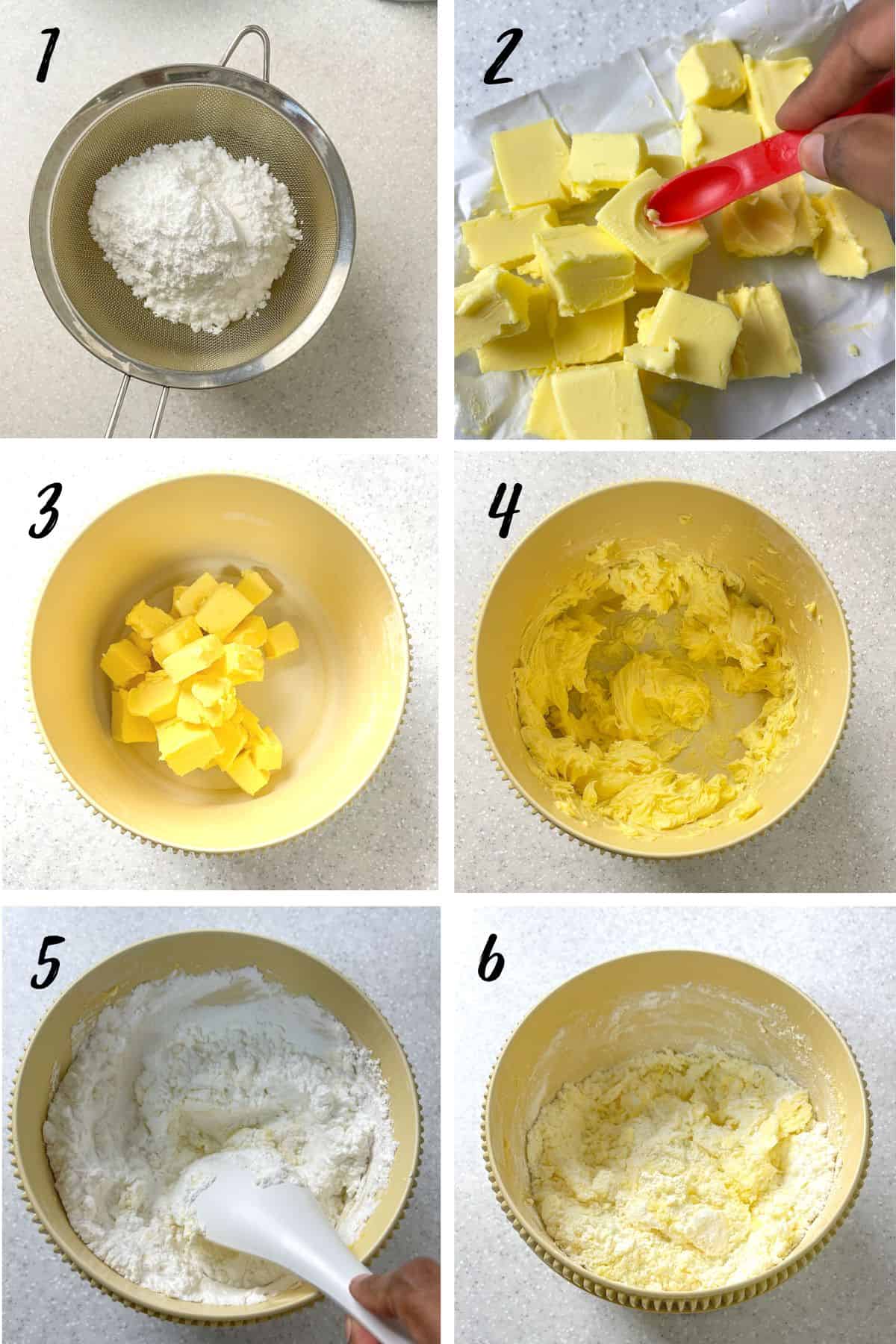
- Start by sifting the powdered sugar to break all lumps. Set aside.
- Cut butter into small cubes. Make sure the butter is firm but soft. You can test by pressing your finger into the butter. It should be soft enough to make a dent and firm enough to hold the shape.
- Add the butter into a large mixing bowl.
- Cream until smooth on medium speed with a paddle attachment on your electric mixer.
- Add in the sifted sugar. Use a spoon or spatula to mix the sugar lightly into the butter. This step will avoid the sugar from flying all over as you turn on your mixer and start beating it into the butter.
- Mix until the sugar is moistened with butter.
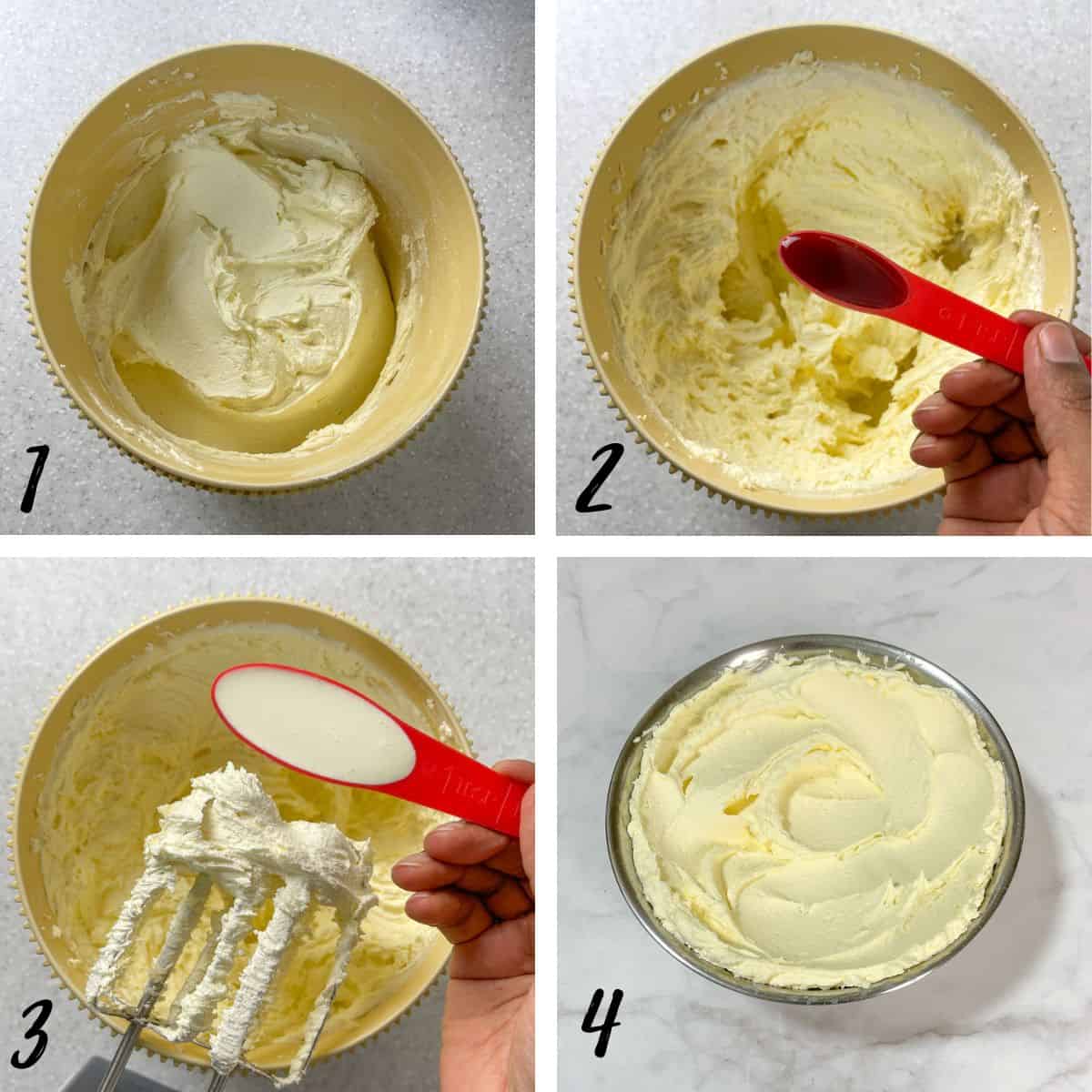
- Turn on your stand mixer or hand mixer on low speed and cream both the sugar and butter. Start with low speed until the sugar is all well incorporated into the butter and then increase to medium high speed gradually until the butter and sugar are well combined and the mixture has turned creamy. Do not overbeat.
- Scrape the sides of the bowl and add in the vanilla extract. Continue to cream the butter and sugar until it becomes of a fluffy consistency, but do note that whipping the butter and sugar for too long will incorporate too much air into the mixture and leave your buttercream with lots of air bubbles or air pockets which will be difficult to be smoothed out.
- Next, add the cream. Add in small increments of half tablespoon of cream or milk to avoid the buttercream frosting from becoming too soft. Skip this step if the buttercream is already soft. The buttercream should be sufficiently firm and soft to be able to piping with a piping bag and hold its shape well.
- Beat again until the cream is well incorporated. If you wish to color your buttercream icing, you can do it at this stage. You can use both liquid food coloring or gel food coloring. Do note that using too much of liquid food coloring can affect the consistency of the icing. Hence, it may be advisable to use gel based coloring as it is more concentrated. Mix well so that the color is even in the buttercream.
This recipe makes approximately 4⅓ cups of buttercream and makes enough frosting to generously fill and frost a two layer, 7 inches round cake with simple piped rosettes design.
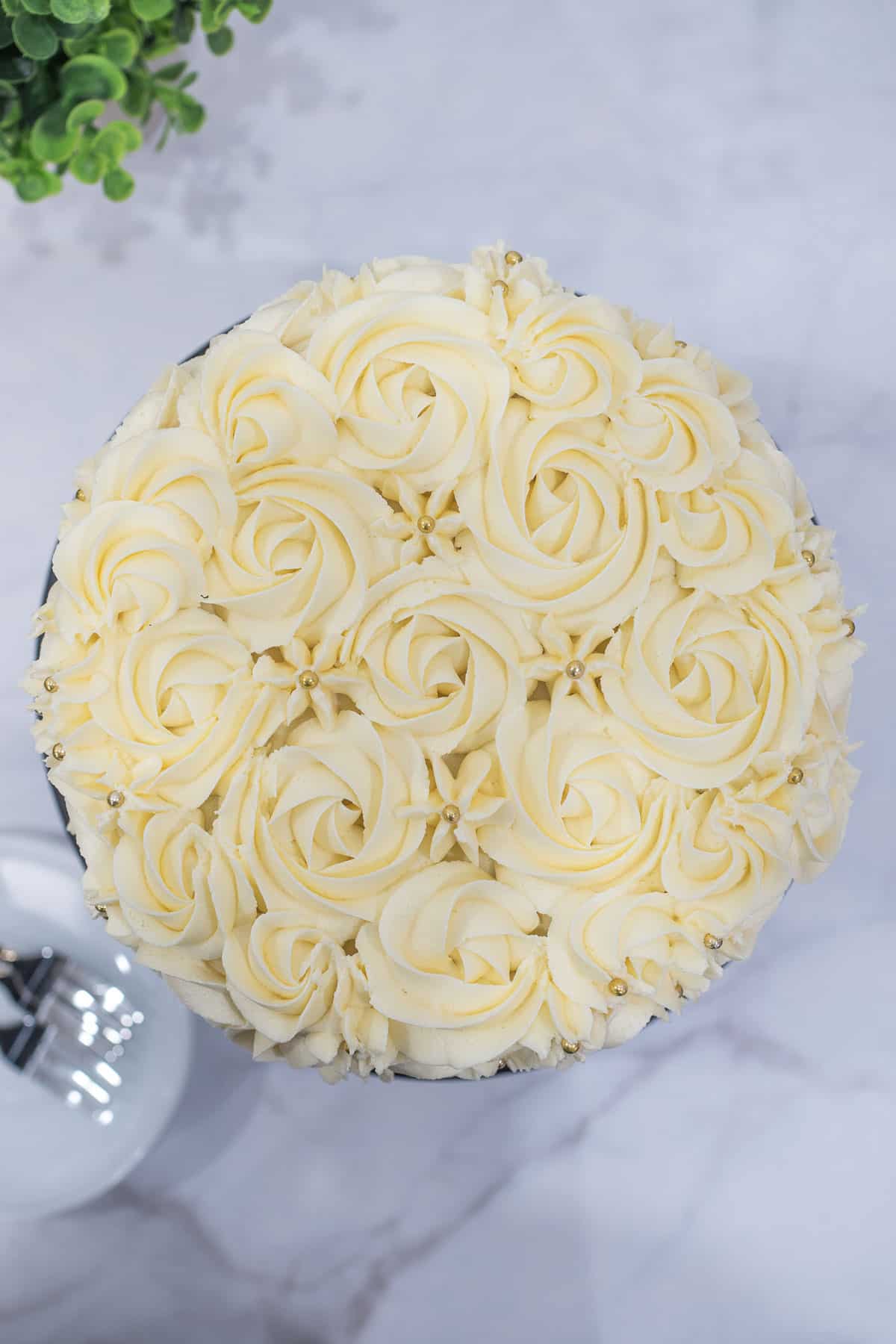
🍽️Serving & storage
- The buttercream can be made it advance and left at room temperature for at least 2 to 4 days (provided the temperature is not too warm).
- This icing can last in the fridge for a good 2 to 3 weeks and in the freezer for up to 2 months.
- If refrigerated, remove it from the fridge at least 30 minutes earlier to allow it to soften. Whip is up for a few minutes to return it to a light and fluffy texture.
- To freeze the icing, place it in an airtight container. Transfer it to the fridge one day before using.
- And right before using, bring the buttercream to room temperature by leaving it at room temperature for about 30 minutes to one hour. Whip it up for a few minutes to make it all creamy and fluffy again.
💡Expert Tips
- This buttercream icing recipe should be made with powdered sugar (icing sugar). Do not use granulated sugar or you will end up with a gritty batch of buttercream.
- Powdered sugar has a tendency to be lumpy. Often, this lumps do not break completely even when beaten with a cake mixer on high speed. As a result, you will see or feel tiny bumps of icing sugar on your cake as you frost it which can be unsightly. The sugar lumps can also block your piping tips especially if you are using any fine tipped ones.
- To avoid this, it is best that the sugar is sifted. Break any lumps you see in your sieve for a smooth buttercream icing.
- If you turn on your cake mixer after adding the powdered sugar, there is a high chance that the sugar will fly all over. It is best that you mix it on very low speed or mix it by hand with a spatula just so that the sugar is all moistened with butter before turning on the mixer.
⭐What can you use the buttercream for?
- As a frosting to frost and decorate cakes of various sizes and shapes, from simple sheet cakes to elaborate tiered wedding cakes.
- As a frosting and to make piped designs for cupcakes.
- As a filling for sandwich cookies or frosting on top of cookies to add flavor and decoration.
- As a frosting for brownies or bars.
- As a filling for pastries like cream puffs, eclairs, and Danish pastries.
- As classic filling for whoopie pies, adding a creamy layer between two cake-like cookies.
- As a filling or frosting for donuts.
- As a filling for macarons.
- To make piped decoration for petit fours.
- As a binding agent to hold cake crumbs together for forming cake pops.
- As a rich and creamy layer in layered desserts like trifle or parfaits.
- To make piped decorations on desserts, such as flowers, borders, and patterns.
💭FAQs
Yes, it does.
This buttercream crusts lightly At room temperature, the buttercream will remain soft, but may for a light crust on top.
When kept in the fridge, the icing will harden, similar to butter.
Buttercream icing or frosting is a classic and popular sweet frosting used mostly for cakes and cupcakes. It is made using one part butter and 2 parts powdered sugar and flavored with extracts like vanilla and fruits.
Salt enhances the taste of the buttercream hence the buttercream is best made using salted butter.
If you using unsalted butter, add a tiny pinch of salt (fine salt) to the butter when creaming it.
To achieve a smooth texture, make sure to use powdered sugar and sift it first to break any lumps.
Adding some cream to the buttercream also helps in making its consistency smooth.
To prevent air bubbles in your buttercream, do not over beat it. Overbeating will incorporate more air and while this makes the buttercream light and fluffy, it will also cause the buttercream to have the unsightly air bubbles.
When adding the sugar, beat only to the point the buttercream becomes creamy. You need to whip it until it is overly light and fluffy.
Yes, you can make buttercream frosting ahead of time. Store it in an airtight container in the refrigerator for up to a week. Before using, let it come to room temperature and re-whip to restore its consistency.
Yes, buttercream is an excellent frosting for piping and cake decorating due to its smooth consistency and its ability to hold its shape well. It can be used to create various designs, flowers, borders, and other decorative elements on cakes and cupcakes.
Buttercream frosting can become soft in hot weather and warm climate and may not be suitable for outdoors and in overly warm temperatures.
If you plan to use it in warm conditions, consider stabilizing the icing with shortening or use a butter and shortening combination to help it hold its shape better.
Yes, it does.
This buttercream crusts lightly At room temperature, the buttercream will remain soft, but may for a light crust on top.
When kept in the fridge, the icing will harden, similar to butter.
❤️More Recipes You Will Love
Do you like this recipe? Please leave a 5-star ⭐⭐⭐⭐⭐rating in the recipe card below and consider a review further down this page. I would love to hear from you. Thank you!
📖Recipe
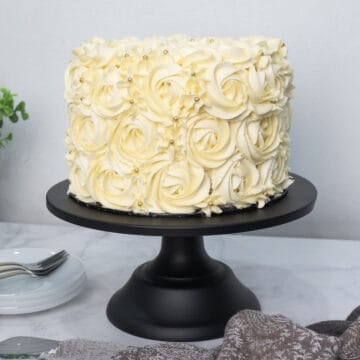
Buttercream Icing Recipe for Cake Decorating
For best results, use the metrics measurements. US customary measurements have not been tested and are only meant for guide.
Ingredients
- 450 g butter (salted)
- 900 g powdered sugar
- 1 teaspoon vanilla extract
- 3 tablespoon heavy cream (or milk) optional
- Food coloring optional
Instructions
- Start by sifting the powdered sugar to break all lumps. Set aside.
- Cut butter into small cubes. Make sure the butter is firm but soft. You can test by pressing your finger into the butter, It should be soft enough to make a dent and firm enough to hold the shape.
- Add the butter into a large mixing bowl.
- Cream until smooth on medium speed with a paddle attachment on your electric mixer.
- Add in the sifted sugar. Use a spoon or spatula to mix the sugar lightly into the butter. This step will avoid the sugar from flying all over as you turn on your mixer and start beating it into the butter.
- Mix until the sugar is moistened with butter.
- Turn on your stand mixer or hand mixer on low speed and cream both the sugar and butter. Start with low speed until the sugar is all well incorporated into the butter and then increase to medium high speed gradually until the butter and sugar are well combined and the mixture has turned creamy. Do not overbeat.
- Scrape the sides of your bowl and add in the vanilla extract. Continue to cream the butter and sugar until it becomes of a fluffy consistency, but do note that whipping the butter and sugar for too long will incorporate too much air into the mixture and leave your buttercream with lots of air bubbles which will be difficult to be smoothed out.
- Next, add the cream. Add in small increments of half tablespoon of cream or milk to avoid the buttercream frosting from becoming too soft. Skip this step if the buttercream is already soft. The buttercream should be sufficiently firm and soft to be able to piping with a piping bag and hold its shape well.
- Beat again until the cream is well incorporated. If you wish to color your buttercream icing, you can do it at this stage. You can use both liquid food coloring or gel food coloring. Do note that using too much of liquid food coloring can affect the consistency of the icing. Hence, it may be advisable to use gel based coloring as it is more concentrated. Mix well so that the color is even in the buttercream.
- This recipe makes approximately 4⅓ cups of buttercream and is sufficient to generously fill and frost a two layer, 7 inches round cake with simple piped rosettes design.
Notes
- For best results, the butter should be firm but soft enough to press with a finger. Sometimes, room temperature butter may be too soft, especially if you are living in a warm temperature. If the butter is too soft to the point it is no longer able to hold its shape, return the butter to the fridge until it firms up before making the buttercream icing.
- If you are using unsalted butter, add about one eighth of a teaspoon of fine salt with the sugar. Do not be overly generous with the amount of salt you add to this buttercream icing recipe. You only need a small amount.
- Butter can be replaced with shortening. You can replace it entirely or proportionately. The buttercream will definitely taste better with all butter in it (without any shortening), but adding shortening stabilizes the buttercream and it will be better able to withstand warmer temperatures. Shortening also helps in making your buttercream naturally white. For heat stable buttercream, replace half of the butter with shortening. For an all white buttercream, replace all the butter with shortening.
- It is a must to sift the powdered sugar before using as powdered sugar tend to be lumpy and these lumps do not always break, even when beaten with a mixer.
- If you turn on your cake mixer after adding the powdered sugar, there is a high chance that the sugar will fly all over. It is best that you mix it on very low speed or mix it by hand with a spatula just so that the sugar is all moistened with butter before turning on the mixer.
- Both gel based food coloring and liquid based colors will work for buttercream. However, gel food colors are best because they are concentrated and you need not use much, especially when you are trying to make deep and dark colors like red. Too much additional liquid can alter the consistency of the buttercream.
- Heavy cream is optional and is not required if your buttercream is not overly stiff. If your buttercream is stiff, and you do not have any cream, you can use milk instead.
- Vanilla bean buttercream - substitute the extract with scrapings of one vanilla bean.
- Chocolate buttercream - sift in 4 to 5 teaspoons of cocoa powder into the icing after mixing in the sugar. If the icing is too stiff, add some milk or heavy cream as indicated in the recipe card.
- Lime, lemon or orange buttercream frosting - Replace vanilla with 1 – 2 teaspoons of finely grated rind (zest).
- Strawberry and raspberry buttercream - Grind freeze dried fruits into fine powder and add to the buttercream after adding the sugar. Start with about 1 - 2 teaspoons of the powder and increase the amount to suit your liking.
- Buttercream frosting in banana, coconut, almond and mint flavors - replace the vanilla extract with these extracts. Use between 1 to 2 teaspoon for the quantity of icing in the recipe card below.
- Coffee buttercream or espresso buttercream - add 2 teaspoons of instant soluble coffee powder after adding the sugar (make sure the coffee is in powder form). Alternatively, mix it with ½ - 1 tablespoon of milk before adding to the buttercream.
- Earl grey buttercream - process about 2 teaspoons of tea leaves into fine powder (add some icing sugar to the tea leaves when processing if your machine requires a minimum volume) and add to the buttercream frosting. The buttercream frosting will have lovely tiny specks of the tea leaves and a great flavor of tea.
- Peanut butter or Nutella buttercream - replace half of the butter in the recipe with peanut butter/Nutella.
- Mocha buttercream - make the chocolate buttercream and add 1½ teaspoon of powdered instant coffee. Alternatively, dissolve the coffee in about ½ - 1 tablespoon of milk before adding to the buttercream.
- Lavender or cinnamon buttercream - add ⅛ teaspoon of lavender/cinnamon powder to the buttercream. Omit vanilla.


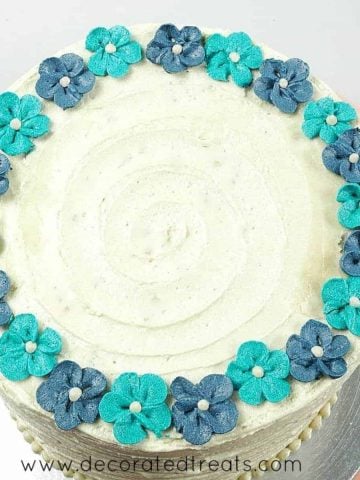
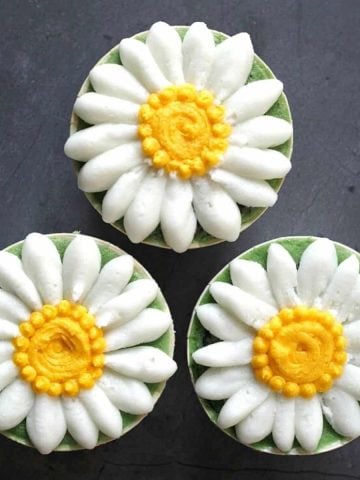

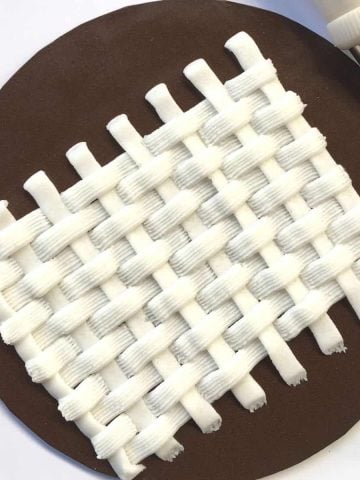
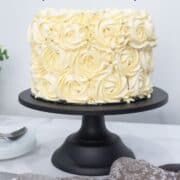
Leave a Reply